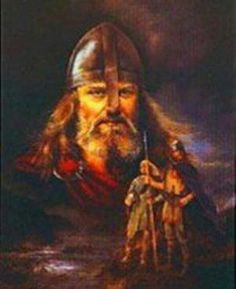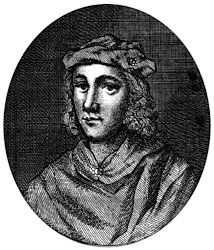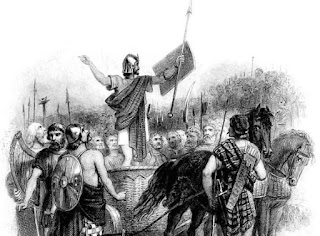Mary Queen of Scots { Part 2 of 2 }
Regency of Mary of Lorraine. First Marriage of Mary Stewart.
.
In 1554, Arran, who had been created Duke of Chatelherault by the French king, went back to France, and Mary of Lorraine became Regent. The league with France was drawn still closer by the marriage of the Queen with Francis the Dauphin. Francis became King of France in 1559. The crown-matrimonial of Scotland was then granted to him, so that the two countries were for a short time united under one crown. On the strength of this the French began to give themselves airs of superiority which the Scots could ill bear from strangers, and before long they became well-nigh as unpopular as the English had been.
The Regent was unconsciously doing her best to foster this feeling of dislike by placing foreigners in offices of trust, above all by making [Pg 93]Frenchmen keepers of the strongholds. But there was another influence now at work, the desire of religious reform, which wrought a change in the national life greater than any that had been felt since the time of the first Robert.
The intercourse with the French which arose from the close alliance of Scotland with France, influenced the social development of the nation throughout this period more strongly than during any other time either before or after it. The members of the National Council when they met in parliament were not, as in England, divided into lords and commons; the representatives of the three Estates, the Barons, the Clergy, and the Commons, assembled in one chamber, as was the French custom. All the tenants holding direct from the Crown were required to present themselves at these assemblies; but James the First released the lesser barons from this attendance, which they felt to be rather an irksome duty than a privilege, by allowing them to send commissaries in their stead. These commissaries, with the deputies from the cities and burghs, formed the Third Estate. The supreme court of justice, the Court of Session, established by James the Fifth, was formed on the model of the Parliament of Paris.
The Universities were founded in the fifteenth century, at St. Andrews, at Glasgow, and at Aberdeen. Of these, Aberdeen was an exact imitation of the University of Paris. The architecture of this period, both domestic and ecclesiastical, is in many respects like the French. Melrose Abbey, and the palaces of Falkland and of Stirling, which were very richly ornamented, were built in the time of the Jameses. The houses of the nobles were also built-in imitation of the French style. There are no remains of burgh domestic architecture older than the sixteenth century.
Many French words also found their way into the Lowland Scotch, as the language of the Lothians came to be called. By this time there was so [Pg 94]much difference between this dialect and that spoken at the English court, that the people who spoke the one could scarcely understand the other. The foreign trade of Scotland was most prosperous during the reign of James the Fourth. Fish, wools, and hides were the principal exports. By this time coal, which is first mentioned towards the end of the thirteenth century, was in general use. There were also lead and iron mines; and gold was found, though not in any large quantities. Of this native gold James the Fourth struck some beautiful coins, which were called bonnet pieces, because they bore the image of the King wearing a bonnet.
The state of the people at this time was one of almost serf-like dependence on their lords. But great as the power of the nobles was, there were no forest or game laws in Scotland, nor did they enjoy any privilege of peerage. An offender against the law, if he could be brought to justice, had to "thole an assize," like any peasant, however high his rank might be.
In early times all the education that was within the reach of the people had been offered to them by the Church. Schools were founded and maintained in several towns by the great monasteries, and there was provision made for the education of the choristers attached to the several cathedral churches. In later times there were Grammar Schools founded by the burgh corporations. In 1496 an Act was passed requiring all "barons and freeholders" to keep their sons at these schools until they should be "competently founded," and have "perfect Latin," under pain of a fine of twenty pounds.
A book, purporting to be the History of Scotland, was written in Latin by Hector Boece, the first Principal of the University of Aberdeen. The greater part of this book is purely imaginary. The Latin "Scotichronicon" of Fordun, was continued by Walter Bower, Abbot of Inchcolm, down to the middle of [Pg 95]the fifteenth century.
Besides the two kings James the First and Fifth, there were other notable poets in Scotland in the middle of the fifteenth century. Blind Harry, the Minstrel, then did for Wallace what about a century before Barbour had done for Bruce, by putting together all the popular stories of his deeds in a spirit-stirring poem that bears his hero's name. William Dunbar, a friar of the order of St. Francis, wrote a poem called The Thistle and the Rose, to celebrate the marriage of James the Fourth with Margaret Tudor. This, and the Golden Terge, and the Dance of the Seven Deadly Sins, are the best among his writings. Gawin Douglas, afterwards Bishop of Dunkeld, the son of that Earl of Angus who was nicknamed Bell-the-Cat, also wrote several poems in the beginning of the sixteenth century. Those best known are King Hart, the Palace of Honour, and a translation of Virgil's Æneid.
Some years after Douglas wrote, Sir David Lyndesay, the companion of James the Fifth's childhood, and the mourner of his untimely death, directed many clever satires against the abuses in the Church, the vices of the clergy, and the follies of the court. The Dreme, the Satire of the Three Estates, and the Monarchy, are his best poems.
_-_Google_Art_Project.jpg)
.jpg)










Comments
Post a Comment